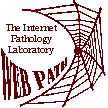- Sections of the appendix show what predominant inflammatory cell type in the wall?
There are numerous PMN's present, typical of acute inflammation. Also seen are marked vascular dilation with congestion and tissue edema (leading to the swollen appearance of the appendix). A fibrinopurulent exudate is present on the surface, producing the gross appearance noted in surgical pathology.
- Through what series of steps are these inflammatory cells undergoing to reach the wall?
Chemotactic factors (such as C5a and leukotriene) are drawing in the neutrophils. The neutrophils are undergoing margination in blood vessels (mainly venules) and emigrating into the tissues.
- In some places the wall shows disruption of the tissue. What is this process?
This is suppurative necrosis (a form of liquefactive necrosis) resulting from the action of the PMN's on the tissue.
- How does the CBC relate to the findings in the appendix?
Leukocytosis and a left shift are typical of many acute inflammatory processes.



